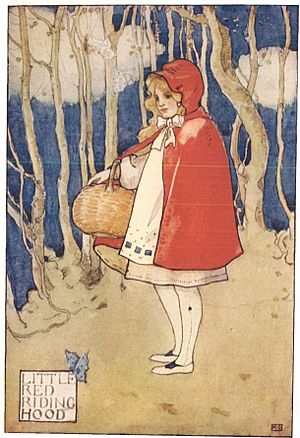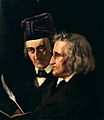Little Red Riding Hood facts for kids
"Little Red Riding Hood" (also known as "Little Red Cap") is a famous French fairy tale for young children. It tells the story of a young girl and a clever wolf. This tale started as a folktale, meaning people told it by word of mouth for many years before anyone wrote it down.
The first written version appeared in the late 1600s, written by Charles Perrault. However, the most well-known version today is Rotkäppchen by the Brothers Grimm, which was written in the 19th century (the 1800s).
Contents
The Story of Little Red Riding Hood
The most common way the story is told comes from the Brothers Grimm. These brothers collected many traditional stories from older people and put them into a book. Their book helped make many "fairy stories" famous. The story's proper German name translates to "Little Red Cap," but in English, we usually call it "Little Red Riding Hood."
The story begins with a girl who wears a special red cap (or a cloak with a hood). Her mother asks her to take food to her sick grandmother. Her mother warns her not to stop along the way.
A wolf sees the girl walking through the woods and plans to trick her. The wolf acts friendly and asks the girl where she is going. The girl answers him because he seems nice. The wolf then suggests that the girl pick some flowers for her grandmother. While she is busy picking flowers, the wolf rushes to the grandmother's house and eats her. He then puts on the grandmother's night-cap and gets into her bed.
When the girl arrives at her grandmother's house, she notices something strange. In the Perrault version, she is surprised by how her "grandmother" looks. "What big arms you have!" she says. The wolf replies, "The better to hug you with!" The girl continues to notice other big body parts, until she sees the wolf's big teeth. "What big teeth you have!" she cries. The wolf answers, "The better to eat you with!" and then eats the girl.
In the Grimms' version, a lumberjack (woodcutter) comes by. He hears something strange and cuts open the wolf's stomach. He saves both the grandmother and the girl, who are still alive inside the wolf. Then, stones are put into the wolf's body to kill him.
How the Story Changed Over Time
The story of Little Red Riding Hood has been told for hundreds of years in different countries. It has had different names. In France, people have probably told this story for at least 700 years. In Italy, there are several versions, like one called The False Grandmother. There's even a similar story from China called The Grandmother Tiger.
In older versions of the story, the wolf was sometimes a scary monster or a werewolf. In one old version, the wolf tricks the girl into eating part of her grandmother's body. The wolf also tells the girl to throw her clothes into the fire and get into bed. The girl cleverly says she needs to use the toilet first. The wolf ties a long string to her so she cannot run away. But the girl ties the rope to something else and escapes.
Charles Perrault's Version
The story was first written down and published in 1697 by the French writer Charles Perrault. It was part of his book, Tales and Stories of the Past with Morals: Tales of Mother Goose. In his book, the story is called The Little Red Cap (Le Petit Chaperon Rouge). Perrault's version was the first printed one, but it was likely based on older spoken stories.
Perrault wanted to teach a lesson about being wise and careful. He wanted to show that young women could be tricked by men with bad intentions. In Perrault's story, the girl is eaten, and there is no happy ending.
Over the centuries, the story has been changed many times. The Brothers Grimm's version is a bit different from Perrault's. In their story, a huntsman kills the wolf and saves the girl from its stomach.
Other Stories with Similar Ideas
Many stories feature a hungry wolf threatening a young person or animal. In most of these tales, the young character escapes by being smart and clever.
One example is the Russian folktale Peter and the Wolf. The Brothers Grimm also told the story of The Little Kids and the Wolf. Another well-known story like this is The Three Little Pigs, first published by James Orchard Halliwell-Phillipps.
There is also an old Norse Legend that has a question-and-answer part similar to what Red Riding Hood asks the wolf. In this Norse story, Thor pretends to be a giant's beautiful bride. The giant asks Thor similar questions, not knowing Thor is really a man in disguise.
How the Story Has Been Used
Other Re-tellings
François Adrien Boieldieu (1775 - 1834) created an opera based on the story. The opera is called Le petit chaperon rouge. It was first performed in Paris in 1818.
In 1927, Sir Compton MacKenzie used Little Red Riding Hood as a main character in his children's novel "Santa Claus in Summer." In this book, Red Riding Hood is the daughter of a highwayman named Riding Hood.
Roald Dahl re-told the story in a funny poem about Little Red Riding Hood. It is part of his collection called Revolting Rhymes.
Lon Po Po is an old Chinese version of Little Red Riding Hood. It won the 1990 Randolph Caldecott Medal for its beautiful watercolor and pastel pictures by Young.
Art
Many artists have painted pictures inspired by Little Red Riding Hood. Some famous artists who have painted scenes from this story include George Frederick Watts, Samuel Albrecht Anker, and François Richard Fleury.
Images for kids
-
Gustave Doré's engraving of the scene: "She was astonished to see how her grandmother looked."
-
"Little Red Riding Hood" illustration by Arthur Rackham.
-
"The better to see you with": woodcut by Walter Crane.
See also
 In Spanish: Caperucita Roja para niños
In Spanish: Caperucita Roja para niños











